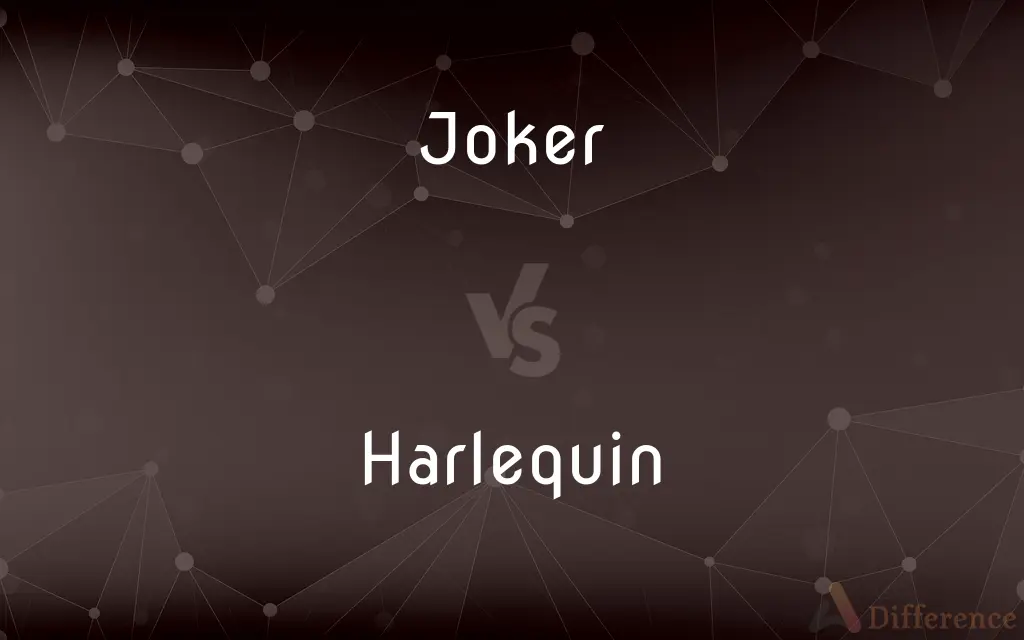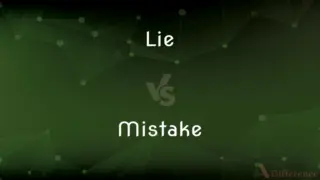Joker vs. Harlequin — What's the Difference?
By Urooj Arif & Fiza Rafique — Updated on March 28, 2024
The Joker, often seen as a chaotic villain in Batman comics, thrives on anarchy and madness, while a Harlequin is a comic servant character in Italian Commedia dell'arte, known for physical agility and tricky behavior.

Difference Between Joker and Harlequin
Table of Contents
ADVERTISEMENT
Key Differences
The Joker is a character deeply embedded in the DC Comics universe, primarily known as Batman's archenemy, characterized by his clown-like appearance and psychopathic tendencies. On the other hand, a Harlequin is a stock character from the Italian Commedia dell'arte, recognizable by his checkered costume, serving as a light-hearted, nimble, and cunning servant.
While the Joker uses his intelligence for criminal activities, often employing elaborate schemes to challenge Batman and Gotham City, Harlequins are typically involved in comedic scenarios that revolve around love triangles, mistaken identities, and slapstick humor, aiming to entertain rather than to harm.
The Joker's portrayal varies across media, from a homicidal maniac to a mischievous trickster, but his intent is invariably malicious. In contrast, Harlequins, despite their mischief, rarely have malevolent intentions; their actions are driven more by a desire for love, freedom, or simply to serve their master's interests.
In terms of origin, the Joker was created in 1940 by Bill Finger, Bob Kane, and Jerry Robinson for DC Comics as a supervillain. Meanwhile, the Harlequin character dates back to the 16th century, evolving from earlier clown figures in Italian theatrical traditions, embodying the characteristics of a clever servant or trickster.
The Joker represents chaos, anarchy, and the dark side of humor, challenging societal norms and morality. Harlequins, while also embodying aspects of trickery and the unpredictable, traditionally symbolize the complexities of human nature, often acting out scenarios that explore themes of love, social status, and human folly.
ADVERTISEMENT
Comparison Chart
Origin
DC Comics, 1940
Commedia dell'arte, 16th century
Role
Villain, archenemy of Batman
Comic servant, trickster
Intent
Malicious, chaotic
Entertaining, seldom malevolent
Symbolism
Chaos, anarchy, dark humor
Human nature, love, social satire
Characteristic Features
Clown-like appearance, psychopathy
Checkered costume, physical agility
Compare with Definitions
Joker
Uses a wide array of gadgets and chemical weapons, usually themed around his clown persona.
The Joker's laughing gas caused uncontrollable laughter, rendering his victims helpless.
Harlequin
Represents the complexities of human nature and love through comedic performance.
Through his antics, the Harlequin explored themes of love, jealousy, and the quest for freedom.
Joker
Appears in various media, including comics, movies, and video games.
In The Dark Knight, the Joker was portrayed as a mastermind of chaos and fear.
Harlequin
Wears a distinctive checkered costume, symbolizing his many facets.
The Harlequin’s costume shimmered under the stage lights, captivating the audience.
Joker
Known for his distinctive clown makeup and unpredictable behavior.
The Joker escaped from Arkham Asylum, leaving a trail of laughter and chaos.
Harlequin
Often involved in romantic plots, using wit and physicality to navigate challenges.
Harlequin devised a clever plan to reunite with his beloved Columbina.
Joker
Often embodies the theme of chaos vs. order.
The Joker believes that under enough pressure, anyone can be driven to madness.
Harlequin
Serves as a bridge between the audience and the play, often breaking the fourth wall.
The Harlequin directly addressed the audience, sharing a witty commentary on the play’s events.
Joker
A notorious villain in Batman series, famous for his psychopathic tendencies.
The Joker’s latest scheme involved turning Gotham's city hall into a giant funhouse.
Harlequin
A light-hearted trickster in Commedia dell'arte, known for his agility.
The Harlequin effortlessly evaded his master, leaping from one precarious position to another.
Joker
A person who is fond of joking.
Harlequin
Harlequin A conventional buffoon of the commedia dell'arte, traditionally presented in a mask and parti-colored tights.
Joker
A playing card, typically bearing the figure of a jester, used in some games as a wild card.
Harlequin
A clown; a buffoon.
Joker
A clause unobtrusively inserted in a bill or document and affecting its operation in a way not immediately apparent.
Harlequin
Having a pattern of brightly colored diamond shapes.
Joker
One who tells or plays jokes.
Harlequin
A pantomime fool, typically dressed in colorful checkered clothes.
Joker
An insolent person who seeks to make a show of cleverness.
Harlequin
A greenish-chartreuse color.
Joker
(Informal) An annoying or inept person
Some joker is blocking my driveway.
Harlequin
(informal) A harlequin duck.
Joker
(Games) A playing card, usually printed with a picture of a jester, used in certain games as the highest-ranking card or as a wild card.
Harlequin
(entomology) Any of various riodinid butterflies of the genera Taxila and Praetaxila.
Joker
A clause that is included in a legislative bill or a contract in order to render the bill or contract inoperative or oppressive in some respect while appearing to be innocuous until the harm has been done.
Harlequin
Brightly colored, especially in a pattern like that of a harlequin clown's clothes.
Joker
An unforeseen but important difficulty, fact, or circumstance.
Harlequin
Of a greenish-chartreuse color.
Joker
A deceptive means of getting the better of someone.
Harlequin
(transitive) To remove or conjure away, as if by a harlequin's trick.
Joker
A person who makes jokes.
Harlequin
(intransitive) To make sport by playing ludicrous tricks.
Joker
(slang) A funny person.
Harlequin
A buffoon, dressed in party-colored clothes, who plays tricks, often without speaking, to divert the bystanders or an audience; a merry-andrew; originally, a droll rogue of Italian comedy.
As dumb harlequin is exhibited in our theaters.
Joker
A jester.
Harlequin
To play the droll; to make sport by playing ludicrous tricks.
Joker
A playing card that features a picture of a joker (that is, a jester) and that may be used as a wild card in some card games.
Harlequin
To remove or conjure away, as by a harlequin's trick.
And kitten, if the humor hitHas harlequined away the fit.
Joker
An unspecified, vaguely disreputable person.
Some joker keeps throwing eggs at my windows.
Harlequin
A clown or buffoon (after the Harlequin character in the commedia dell'arte)
Joker
A man.
Harlequin
Variegate with spots or marks;
His face was harlequined with patches
Joker
A clause in a contract that undermines its apparent provisions.
Joker
(military) A friendly unit that acts as a suspected hostile unit in a military excercise.
Joker
One who makes jokes or jests.
Joker
See Best bower, under 2d Bower.
Joker
An extra card usually included in a deck of playing cards, having the same design as the others on the back, but on the face having a picture of a jester. It is not included in the deck used in most games, but in certain games may be included and then takes on a special value, such as the highest-valued card, or a wild card.
Joker
A clause placed in a document, such as a contract or a piece of legislation, not itself appearing significant, but in a subtle way substantially changing the effect of the document.
Joker
Any fact or condition which is unknown or not apparent, which reverses an apparently advantageous position; a kicker.
Joker
A person; a fellow; a chap; - usually used in a mildly disparaging sense; as, who's the joker who left the ice cream on the table?.
Joker
A person who enjoys telling or playing jokes
Joker
A person who does something thoughtless or annoying;
Some joker is blocking the driveway
Common Curiosities
Can the Joker be considered a type of Harlequin?
While the Joker shares some superficial traits with Harlequin, such as a penchant for tricks and a distinctive appearance, his role as a villain with dark motives sets him apart significantly.
What is the primary difference between the Joker and Harlequin?
The Joker is a villain known for his malevolence and chaos, while Harlequin is a comedic character from Italian theatre, often engaging in light-hearted trickery.
What is the significance of the Harlequin's costume?
The Harlequin's checkered costume is symbolic of his multifaceted personality, agility, and the dual nature of human emotions.
What makes the Joker a compelling villain?
The Joker's unpredictability, depth of madness, and philosophical challenge to Batman and societal norms make him a complex and compelling villain.
Do the Joker and Harlequin share any similarities?
Both characters are known for their distinctive costumes and roles that involve trickery and unpredictability, but their intentions and contexts are vastly different.
Where did the Joker originate?
The Joker first appeared in DC Comics in 1940 as a supervillain and archenemy of Batman.
Are there any modern interpretations of the Harlequin character?
Modern interpretations of Harlequin often focus on his role as a trickster and lover in theatrical performances, retaining his agility and wit but sometimes updating his costume and context for contemporary audiences.
How has the Joker's character evolved over time?
The Joker's character has seen various interpretations, from a mere prankster to a psychotic villain, reflecting societal fears and the evolution of the comic book genre.
Does the Harlequin have any supernatural abilities?
Traditionally, Harlequin does not possess supernatural abilities; his skills are more about physical agility and cleverness.
In what ways does the Joker challenge Batman?
The Joker challenges Batman not just physically but intellectually and morally, often forcing Batman to confront the darkness within himself and Gotham City.
What role does Harlequin play in Commedia dell'arte?
Harlequin serves as a comic servant, often involved in romantic escapades, trickery, and interacting with the audience, embodying themes of love and social satire.
How is the Harlequin's role significant in Commedia dell'arte?
Harlequin's role is crucial for introducing comedic elements, engaging with the audience, and driving the plot through his schemes and relationships.
Has the portrayal of the Joker changed in modern times?
In modern portrayals, the Joker has often been depicted with deeper psychological complexity, reflecting contemporary concerns about mental health, violence, and societal decay.
How do audiences typically react to Harlequin's antics?
Audiences are usually entertained by Harlequin's physical comedy, cleverness, and the light-hearted relief he provides within the dramatic structure of Commedia dell'arte.
What themes does the Joker explore through his character?
The Joker explores themes of chaos, anarchy, the nature of evil, and the thin line between sanity and madness.
Share Your Discovery

Previous Comparison
Lie vs. Mistake
Next Comparison
Simplex vs. SimpleAuthor Spotlight
Written by
Urooj ArifUrooj is a skilled content writer at Ask Difference, known for her exceptional ability to simplify complex topics into engaging and informative content. With a passion for research and a flair for clear, concise writing, she consistently delivers articles that resonate with our diverse audience.
Co-written by
Fiza RafiqueFiza Rafique is a skilled content writer at AskDifference.com, where she meticulously refines and enhances written pieces. Drawing from her vast editorial expertise, Fiza ensures clarity, accuracy, and precision in every article. Passionate about language, she continually seeks to elevate the quality of content for readers worldwide.
















































